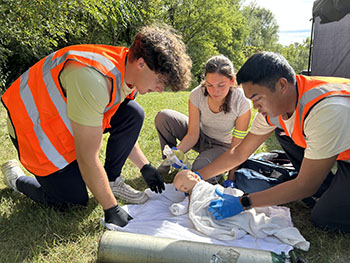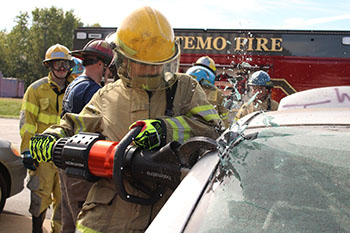
The medical school’s newest students wrapped up their Medical First Responder (MFR) training course in early October, putting their skills to the test during a capstone event at the Kalamazoo Regional Public Safety Training Center.
The all-day event was held on Thursday, October 2, 2025, and consisted of several emergency scenarios, including a mass-casualty incident, a vehicle extrication, responding to a half dozen complex medical emergency cases, and rappelling down an elevator shaft.
“As first-year students, a lot of our time is dedicated to studying,” M1 Yashmeet Kaur said. “With MFR, it’s been nice to gain hands-on clinical experience working on these cases. Getting to apply that knowledge during capstone, you could really see everyone coming together and for us now, responding to an emergency has really become second nature.
“EMS is all about working with what you have, being able to adapt and do whatever is needed in the situation,” Kaur added. “It feels like a lot when you’re going through the course, but I have gained so much from this experience.”
WMed students spend some of their very first weeks of medical school participating in MFR training. The two-week course culminates with the MFR capstone event, and the training qualifies students for national certification and state licensing as medical first responders.

“The teamwork that is so important to be successful in the MFR course is the same kind of teamwork that you need to be a successful physician and a successful healthcare team member,” said William Fales, MD, professor in the Department of Emergency Medicine and division chief for the Division of EMS and Disaster Medicine at WMed. “While most of these students might not be going into emergency medicine, they are going to be doctors and it may be a patient who collapses in their waiting room, it may be a neighbor, or maybe a family member that needs someone to step up and do some simple, but really important things for the first few minutes of an emergency until help arrives. We’re a little biased, but we think every physician should know how to handle the first five minutes of an emergency, regardless of what kind of specialty, and that’s what we really try to do in MFR.”
As part of the medical school’s first-year curriculum, the MFR course equips students to respond when someone is ill or injured and provides them with instruction on basic procedures, including taking vital signs, CPR, bandaging, wound care and splinting, administering life-saving medications like naloxone and epinephrine, and assisting in childbirth, among other things.
“MFR has been very rewarding,” M1 Brooke Sherman said. “This course has really made us practice critical thinking. When we get on scene, we have to be quick on our feet and make quick decisions. We wouldn’t really get this kind of clinical exposure this early in any other way. It’s been a great experience, and it’s really strengthened my interest in emergency medicine.”
